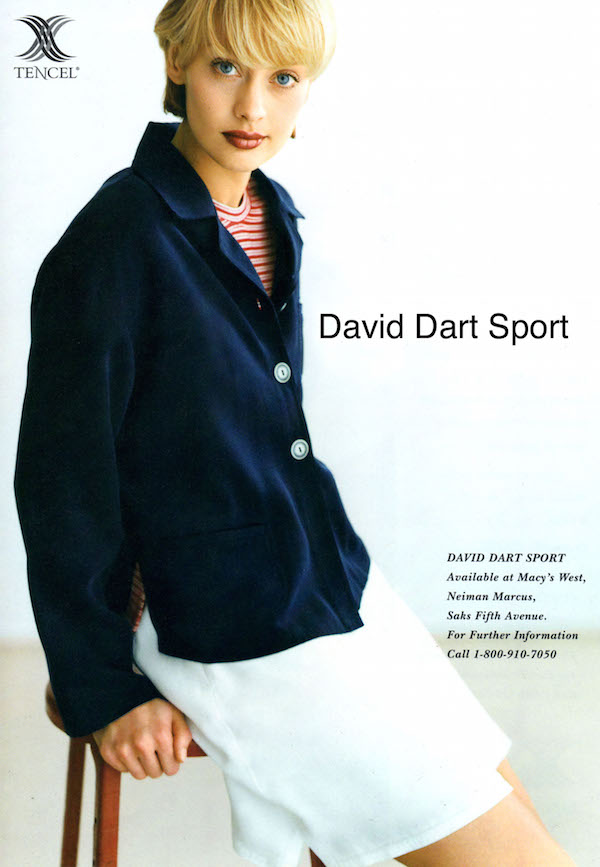
TENCEL® fibers in the Beginning
A look back in time with some of the designers who first recognized the fashion potential of a fiber ahead of its time —and who early on embraced one of its key qualities: sustainability.
In 1992 TENCEL® branded lyocell fibers came on the scene full of promise and its qualities attracted fashion designers, including Adriano Goldschmied, Sigrid Olsen, Jhane Barnes and others, like honeybees to a flower.
“For me, as a designer, it opened my eyes to the versatility of the fabrication, creating a whole new category of business in the casual arena,” Sigrid told Carved in Blue.
Carved in Blue asked some designers who were there during the early days of TENCEL® fibers to describe their encounter with a textile that was derived from wood pulp and carried such diverse characteristics. Many remember when they first encountered TENCEL® fabrics — at a conference or show or at a mill—and all remember how it felt.
 Trouble at mill
Trouble at mill
Initially, and especially when it came to denim, TENCEL® fibers had more promise than power. It would be up to the designers and the makers to figure out how to harness what this revolutionary fiber had to offer.
“If we go back in time, there are very few fibers that have been invented or introduced to the industry and even fewer that have been successful in the denim arena,” says design consultant Stefano Aldighieri, who has served as creative director at 7 For All Mankind, Levi’s and is now consulting for Arvind Denim.
Of the initial challenges in working with the unknown fabric was the property of fibrillation, which was initiated during dyeing wet processes. “Eventually we found that it was not really a big deal,” Stefano said. “If you knew how to treat it and control it, it was actually a positive feature. But at the beginning it was one of those things you’d lose sleep over.”
Raphael Javaheri, now CEO of premium fabric maker ECOTEX, was determined to make it work, after reading about TENCEL® fibers in Women’s Wear Daily in 1990 or so, when he was still working the family business, his father’s textile company Milano Textiles Inc.
“Of course I didn’t know what I was getting into, but I loved every moment of it, even the days we kept having recurring fibrillation issues,” he told us. “It took about 12-18 months, with much patience, investment and technical support with my close friend Victor Almedia to perfect our formula and have commercially viable product in large quantities. Truly it was a team effort from all the support we got from [original innovators] the Courtaulds family to our contract weavers (New Cherokee Mills, JP Stevens & Dan River) to our dye house and chemical companies. Everyone stood to gain much and we all risked a lot to make it happen.”
From that point Milano Textiles started designing and developing an extensive collection of TENCEL® fabrics in denim, chambray, PFD, yarn dyed, prints, jacquards, dobby, 100% TENCEL® fibers and TENCEL® blends with rayon, cotton, linen, spandex and more—selling to top U.S. brands and retailers as well as a robust export business to the U.K. (M&S and Next) Japan, Australia, and New Zealand.
Michael Lew, now designer at Imaginery Concepts Inc. was working at Graniteville Denim and Silver Textiles and had to find the right partners to help him figure out how to tame the new fiber. “It was very difficult to handle and achieve the finish,” he said. “We had to find the best wash housed in LA who could handle the garment-washing process with the dyeing and finishing experience to achieve the special luxurious hand feel that makes TENCEL® unique. Once we found out the formula with so many trials we finally figured it out—and the rest was history.”
The discovery
While working for Ann Taylor Stores in New York as the “ATX” weekend casual designer in the early 1990s, creative design consultant Jacquie Rumohr, remembers seeing swatches with TENCEL® fibers from their denim vendor. “I thought it had a great look, drape and hand,” she said. “My appreciation for TENCEL® originated then and has never left me—sort of a first love in fabric form! I got really excited about the concept of this new innovative fabric as an amazing way to build a casual yet luxury collection.”
Not all encounters were accidental. David Rose, now president of Circuit by InRoads motorsports-inspired apparel for men and women, remembers finding it at the the Interstoff Textile show in Frankfurt in the early nineties. “I was looking for a fabric that would be uniquely special. I had no idea what that fabric might be but was pretty sure I would know it when I saw it,” he told Carved in Blue. “At one of the stands I saw a fabric that got my attention, but, although it had the luxurious hand-feel that I wanted, it was designed for womenswear and the construction and weight was not suitable for men’s trousers.”
David went on to work with the mill to develop the appropriate weight, and helped launch the fiber in menswear. “With that success came much attention from the trade press and we became known as ‘the company with the TENCEL® trousers,” he says. “We expanded to other TENCEL® fabrics including denim, and soon many other menswear firms were also offering fabrics with TENCEL®. One of the main attributes of TENCEL® is its luxurious hand-feel. Suddenly there was a means of making denim look elegant while maintaining the overall look and character that the consumers wanted from denim.”
Imaginery Concepts Inc.’s Lew was similarly on the hunt for new fabrics, and similarly came to bring it into the fold. “They told me about the TENCEL® fiber,” he said. “I was intrigued with the innovation and that the EU and Japanese market were into it already, so I sampled the fabric and it became our staple fabric for the winning collection for the Marty Awards in 1994.”
Textile designer Katsu Kawasaki first encountered the fiber in Tokyo in 1995, and told Carved in Blue that the experience “was sensational on so many ways, the feel of TENCEL®.”
“I was thrilled to be part of marketing team for the American market in 1997 and after,” Katsu said. “We could introduced basic 2×1 and 3×1 twill and plain weave fabric for both men’s and women’s volume jackets and suites. Our strength were stability of fabric and continuous product development, including novelty fabric.”
A revolution ahead of its time
The contribution of TENCEL® fibers to denim were emerging and evolving this way. But few designers have seen the importance of TENCEL® fibers to denim making as speedily or as thoroughly as Adriano Goldschmied, “The Godfather of Denim,” who calls it “A fiber that I love.”
“I love it so much that I decided to make a brand that was only about TENCEL®,” he told Carved in Blue. “In 1993 I started A Gold E that was about denim and PFD in TENCEL®. We had immediate success. The idea of a fiber and a fabric with properties different from cotton—feminine and great hand-feeling—was a thing that was missing in the market. At the time, denim was a fabric that was heavy and stiff. So TENCEL® was a revolution because it was able to make a jean with a completely different hand feeling and in terms of design.”
Fabrics with TENCEL® fibers has had a part in Adriano’s work ever since, he says. But, as more designers began to discover how fabrics with TENCEL® fibers behaved, felt to the touch and could work for them, few were paying attention to another important attribute. “One of the concepts of the brand was also sustainability, which at that time was a very new thing,” he says.
Indeed, Adriano was one of the few in the industry then who embraced an ecologically minded approach to garment manufacture. That meant that the environmental responsibility of TENCEL® fibers went largely unappreciated, and in many quarters it was misunderstood.
“I truly believe TENCEL® give denim industry much needed conscience,” Raphael says. “We all love to call Adriano ‘the Godfather of Denim.’ Well, I like to think of TENCEL® as the Godparent of eco-friendly and sustainability by design. Before TENCEL®, no one cared much, or, if they did, they didn’t know what to do. But 25 years later, the biggest marketing keywords every brand and retailer is trying to portray themselves in the age of social media consumerism is that they are eco-conscious and sustainable as the millennials and Gen X shoppers nowadays care about where anything they buy comes from, and they want to feel good about their purchase.”
“Back then, people considered TENCEL® just another synthetic fabric, even though it shouldn’t be categorized that way,” agrees Katsu. “I had a hard time convincing many people in apparel companies here in the U.S.A.”
That certainly has changed and with sustainability as one of the most critical challenges of garment making today, that aspect of TENCEL® fibers is now at the forefront of the industry’s future. Denim design has changed due to TENCEL® fibers —by expanding its potential in fashion. Next, thanks to TENCEL® fibers, denim design may help change the world.
“Denim and TENCEL® are able to give the perfect interpretation to any new trend that is in fashion. I see TENCEL® as a kind of silent partner of denim. It is part of denim history,” says Adriano. “One thing that has to be a rule, from now on in the future, is that the fashion and the design doesn’t have to go against a sustainability concept.”






